VARIOUS VISITS GB
CONTENTS (scroll down to see everything)
See also "Les Musées - Fr
A VISIT TO SAINT MARTIN DES PUITS, posted December 2010
Villarzel-Cabardes November 2010
La Vernède, l'Hérault 2006 to 2009
pour les français, regardez cet article sur http://viaaquitana.blog4ever.com
Baziège, near Toulouse
A VISIT TO SAINT MARTIN DES PUITS
So many times people zoom through the village of St. Martin des Puits and never see the chapel!


From the road . . . close-up of the Romanesque door
Take the road south from Lagrasse in the Corbières, then turn right to St-Pierre-des-Champs on the D212. St. Martin is the next village, about 6km further along. But slow down as you reach the village; the road bends to the right, and the chapel is beside it on the right. But the road is considerably higher (in itself evidence the chapel is very old) and looks from the road like just another roof. Look for the little triangular bell-tower; if you can see it behind a tree!
I visited the chapel on a Sunday afternoon, and it was open. There wasn't a soul about and no notice on the door; it might be a good idea to check with the Mairie for opening times before you go, tel 04 68 43 11 66. Usually a local resident might have the key to open up for you.
History tell us this church was once a Carolingian monastery – well it must have been a tiny one! - that was ceded to Lagrasse in 1093. The trouble is that historians can only quote according to their earliest written records, and I believe St. Martin des Puits to be much older than that – Visigothic, in fact. But when Charles Martel ravaged the region of 737AD many Visigothic records were destroyed.

Inside the church you will see a horseshoe arch separating the nave from the altar. This is typically Visigothic. All the experts agree that the capitals above the pillars holding it, are Visigothic. The pillars themselves are “antique marble re-used.” Maybe even Roman. So it sounds to me that the church, maybe much smaller, existed in the eighth century and was renovated several times. The last one was done in 1853 – see the date above the arch.
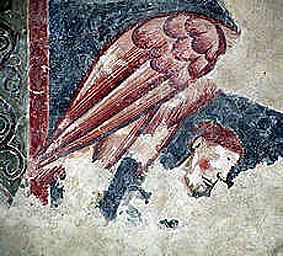
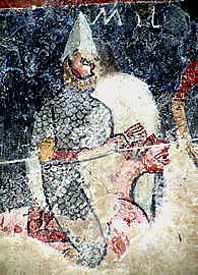
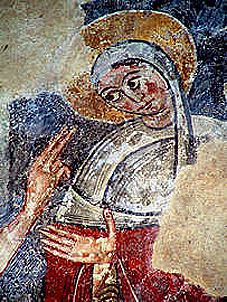
Behind the altar are beautiful frescos – these are 12th century, as you can confirm by the picture of a knight on horseback. There is a preservation order on them as on the whole church. One can see why, the inside is truly beautiful with it's own ambience.
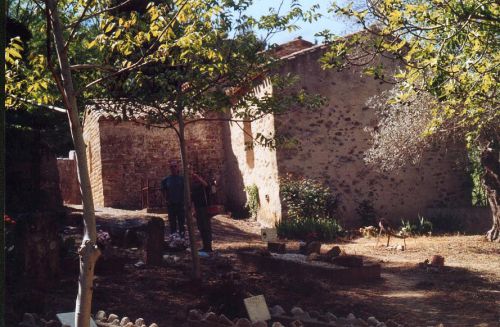
Outside is a tiny graveyard. Standing it it one sees clearly the Romanesque style of the doors and windows. I believe the door on the left was not the original entrance – that would have been where is now the road, for the church was orientated west-east, as Visigothic churches always were. One entered St. Martin des Puits and saw that lovely arch straight ahead, and the frescoes.
Villarzel-Cabardes
This tiny village in the Minervois, some 12km north-east of Carcassonne, houses a local museum that is an absolute delight. It is well sign-posted. We were three - fellow members, Malcolm and his wife Claude, had come all the way from Cluny in Burgundy to find out more about the Visisgoths in the Narbonnais region.


The first thing we saw, just outside the museum, is a sarcophage in which was found the body of a young Visigothic woman; her jewelry is featured inside the museum. The sarcophage was one of those in the Visigothic cemetary called Mourel des Morts, just to the north of Villarzel; the museum curator will give you exact instructions to find it. One has to walk there (unless your car is a Land-rover) but we couldn't face the walk in the rain.
The museum is not just devoted to Visigoths, but houses collections of various archeological digs in the vincinity and the finds are dated from Celtic to Medieval times. The whole Minervois is dotted with the remains of Roman villas; the Roman finds, especially the pottery, are magnificent.


The curator explained things very clearly and is a passionate enthusiast for his work.


Here is the map in the mseum showing all the areas where excavations have been made.

Sites at Larcat and Les Agals are pre-Christian. On our way, on the Laure-Minervois road approaching Villarzels, we had passed the Chateau of Villarlong. From there one can easily walk to find the ruined pre-Medieval chapel of Notre Dame de la Lauze. Again, we didn't have time to find it, but knew off it because the curator, Louis Guiraud, and the Société Archéologique de Vllarzels Cabardès, often do exhibitions at local events.

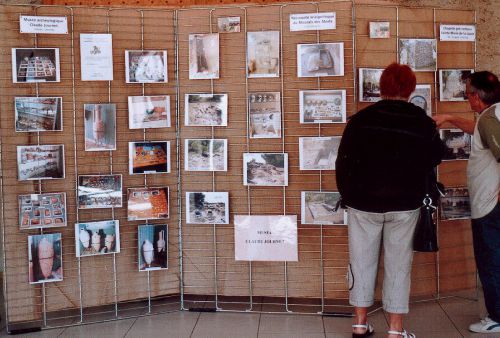
The museum has quite a collection of potterie sigillée and poterie noire; we admired the way these were represented, with enlarged photographs of the pieces.


Then we moved into the second room, where there was a selection of items from the Visigothic cemetary - including SKULLS!
 these were real Visigothic people who lived over a thousand years ago . . . on the shelf below, was the jewelry found in the tomb of the young woman. It's thought, by the quality of her jewelry, that she was a princess.
these were real Visigothic people who lived over a thousand years ago . . . on the shelf below, was the jewelry found in the tomb of the young woman. It's thought, by the quality of her jewelry, that she was a princess.

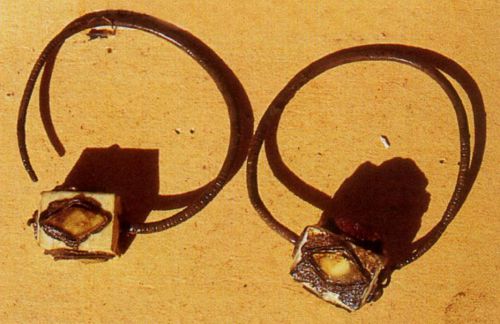
(The amber earrings on the right, "found near Carcassone" which could be the Minervois, for comparison.)
There was also displayed a tomb made from Roman roof-tiles. I was fascinated by this, as I had never heard of it before; but the Roman roof-tiles, with a ridge on one side so the tiles could overlap each other, were strong and heavy, and maybe people had some left over after building their houses.


There was much more; pre-Christian pottery made by the ancient Gauls, of classic design that would sell in drawing-rooms today, plus some medieval items. It was so-well done it could be a teaching model of how to design a modern museum. We were impressed!
In front of the museum is a delightful garden, with a lawn and a bench under a tree where you can sit in the heat of summer; all all the walls are covered with murals with scenes from history.




There was also a mural showing the Visigothic princess, with a village of wooden huts behind; It was poetic and nicely done, but the Visigoths built in stone as the Romans did, indeed, the Romans had taught them. And the young woman's costume was not very accurate.

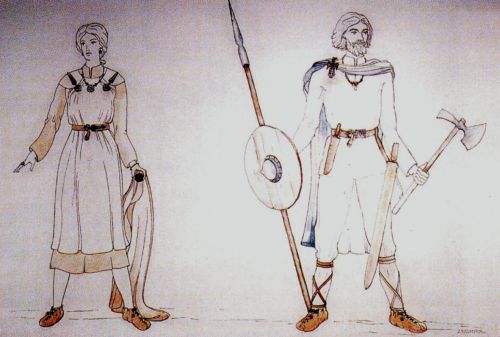
It is notoriously difficult to know what people wore, because cloth deteriorates rapidly in grave conditions. However, the comparison picture is a drawing the the Archeological Museum of Madrid. You can see that ladies wore a basic shift with a shorter tunic dress over it, that would be fixed with jewelery and belts. The men wore shorter tunics over trousers and leggings. Note the bird shaped brooch holding his cloak in place.
What now? We really want to see the nearby Mourel des Morts, where the Visigoths were buried from the 5th to the 7th centuries, nobody knows from where, and the Château at Villarlong but one needs fine weather.
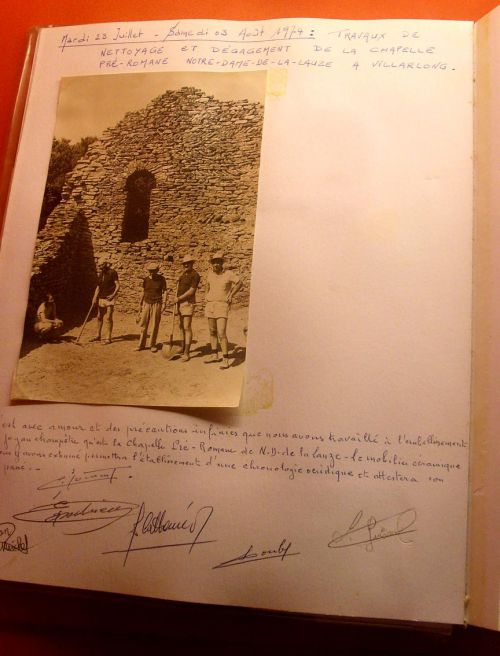 This is a page from the Visitor's Book dated 1974. The museum began in July 1967 when the first Visigothic discoveries were made, only 53 years ago. They have found so much since then.
This is a page from the Visitor's Book dated 1974. The museum began in July 1967 when the first Visigothic discoveries were made, only 53 years ago. They have found so much since then.
To book a visit ring M. Louis Guiraud on 04 68 77 02 11. He will open up for you (within office hours.) There is no charge but you will want to make a contribution to the box provided. Leaflets are available in English and many English visitors have signed the book.
La Vernède 2006 to 2009
I first visited La Vernède in July 2006 when I heard there were Visigothic graves there. La Vernède is a wine château on the border of Aude and l'Hérault, near the village of Salles d'Aude, from which it is sign-posted. A friend had seen a sign-post saying "Site Visigothique" so I had to go and see it.
There were Visigothic graves and then various items in the small museum in the wine-tasting room, where are kept the barrels of wine, lodged between small walls which were originally those of a Roman villa.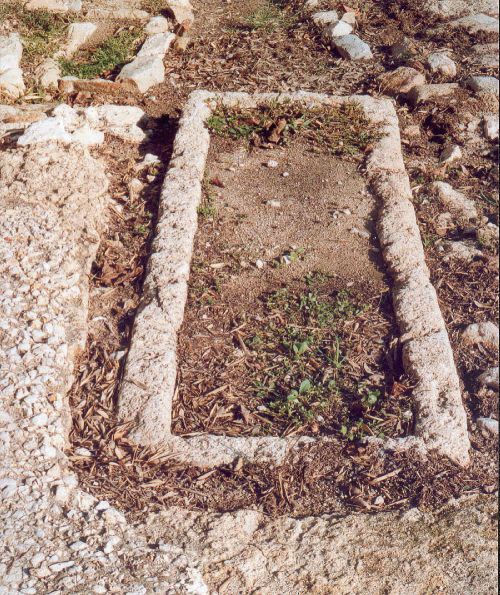
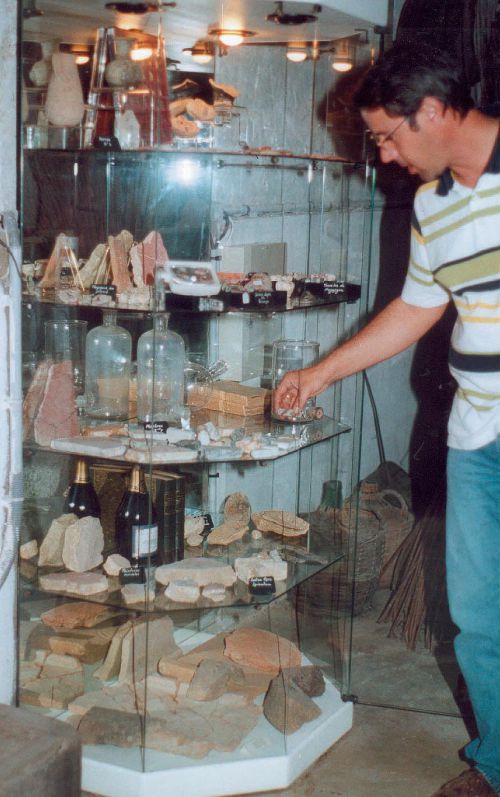
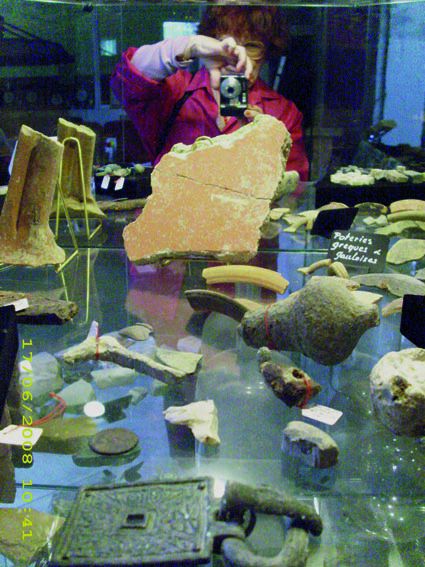
Above; a Visigothic grave; Jean-Marc; me reflected in the mirror, photographing the belt-buckle.
I was very impressed by the owner, Jean-Marc Ribet. He is a wealthy business man with many calls on his time, but he spent at nearly two hours talking to us (we had rang in advance) because history is his passion. He had discovered that La Vernède was the site of a great Roman villa that was destroyed "in the barbarian invasions." As he had found Visigothic remains there, particularly a belt buckle, he thought the villa had been burned by the Visigoths. But no, I found out it had been destroyed by the Vandals, in the early 3rd century. They swept on their way afterwards and the villa fell into ruin.
When the Visigoths came they lived here, and buried their dead in stone tombs (as above) not realising that they were digging through an ancient Roman mosaic floor.
However, on the site was discovered the remains of the Chapel of Ste. Cécilia; Roman or Visigothic, no one seems to know, so La Vernède must have been one of the earliest places to become Christian. Jean-Marc Ribet has since named his daughter Cécilia - plus his most elegant wine.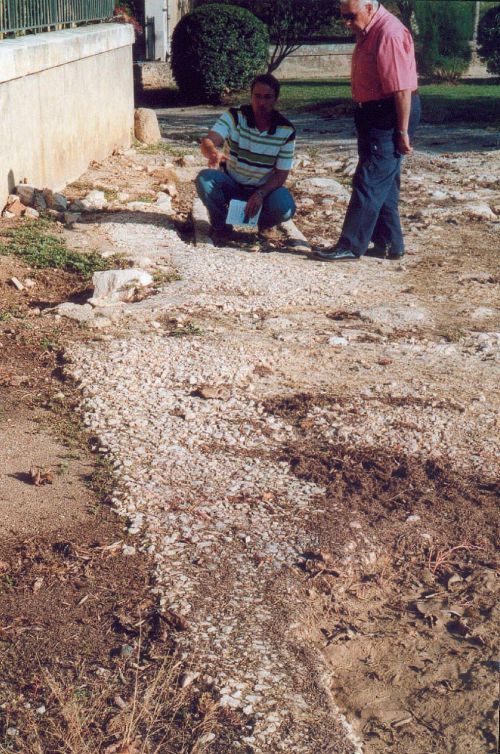
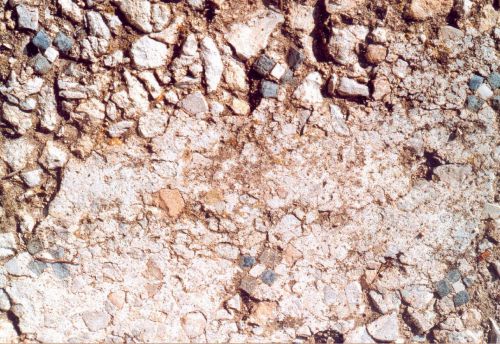
Meanwhile, the road running in front of the château was a tiny municipal road; it was decided the route should be changed slightly, to run outside the château grounds, and when the gravel and tarmac was cleared away, remains of mosaics were found only 10cm below the surface! They were very worn, but you can perceive the pattern of tiny dark flowers with white centres on a neutral background.
Then, in the Spring of 2008, I received even more amazing news, from my friend Barry Gray, a Canadian archeologist who had helped with the excavations at La Vernède. The remains of the municipal road had been taken up and yet more mosaics were discovered. They were splendid and quite early, probably first century AD.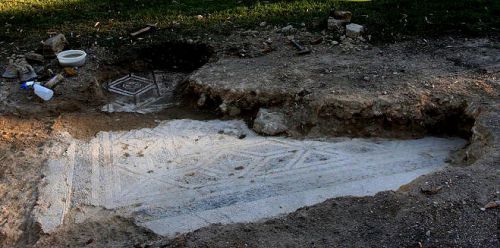
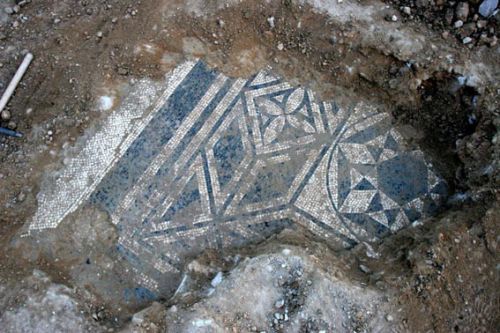
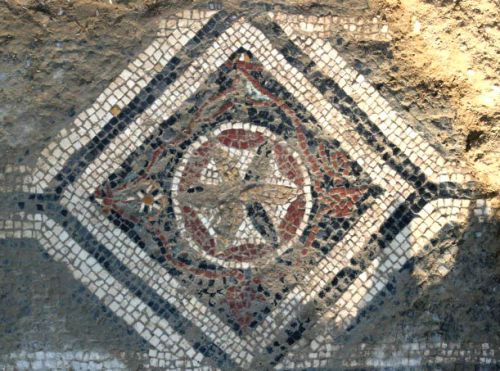
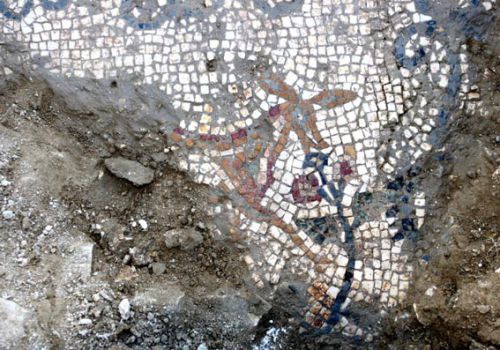
The "diamond" and the "mischievous deer eating a flower" were particularly charming. This find was exciting indeed. By this time I had joined the Via Aquitana Association in Canet, and so Nicole Juan and I went to La Vernède for a reconnaisance. (For details of the Via Aquitana Association, see http://viaaquitana.blog4ever.com )
Once again, Jean-Marc Ribet was the perfect host. It was a rainy day, but he cleared the rain off the mosaics so we could see them, and explained, while we looked at the little museum in the tasting room, of all the things he had discovered. These included much Roman glass and coins dating from 100BC to the early 8th century. Why had everybody left in such a hurry? It was probably because Charles Martel ravaged the region in 737, leaving Languedoc a wasteland.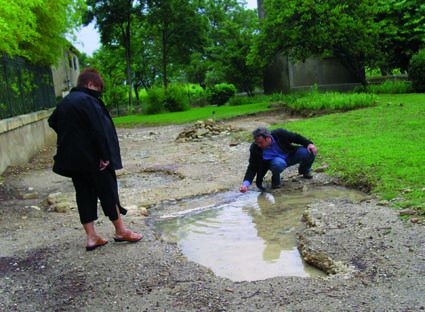
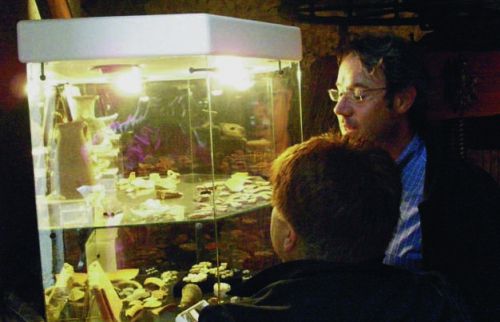
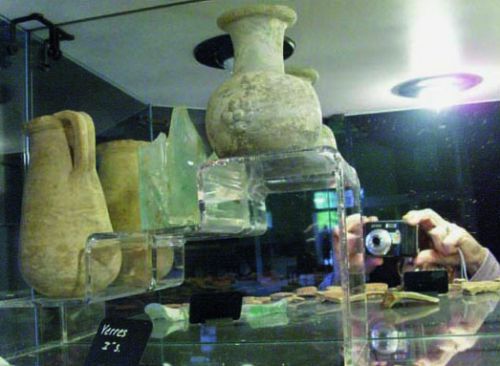
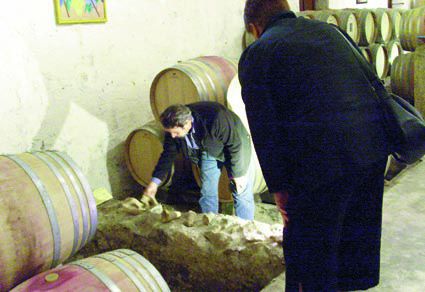 Barrels stored in the remains of Roman walls.
Barrels stored in the remains of Roman walls.
A formal excursion was arranged; La Vernède is near the route of the old Via Domitia . Everybody was impressed that we were among the first people to see these newly revealed mosaics - underneath what was once a municipal road!
Jean-Marc explained further; In the grounds is a 30 metre Roman wall, beyond it is today's château and between the two is where the mosaics were discovered.
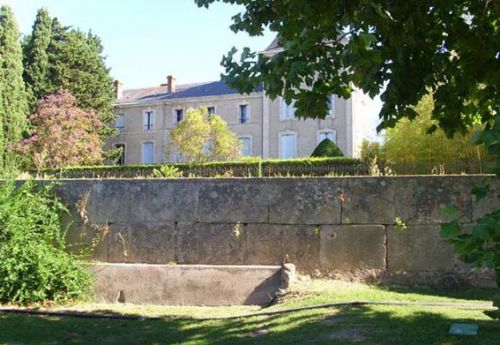
The first mosaic shown in this article, with the tiny black flowers, was the floor of the entrance hall which led to a huge living and dining area, with the more ornate mosaics. There the Roman aristocracy would sit - eating oysters. Then they threw the oyster shells over the wall into the artificial lake filled with goldfish - this was Roman luxury indeed! We found many oyster shells; they don't decay and can be found wherever the Romans lived in Gaul.
Then we repaired to the tasting room to sample the wine and buy some. La Vernède wine is not sold in ordinary shops, but always through the château, including exports abroad. The Merlot and Cabernet Sauvignan were excellent for 5€ a bottle, and the excellence improved until we found a single mouthful of Cecilia was the experience of a lifetime!
Later I received a photo from La Vernède. The Visigothic grave that the Visigoths had dug, all unknowingly, through the mosaic floor of the villa, had been excavated and in the grave was a skeleton of a Visigoth.
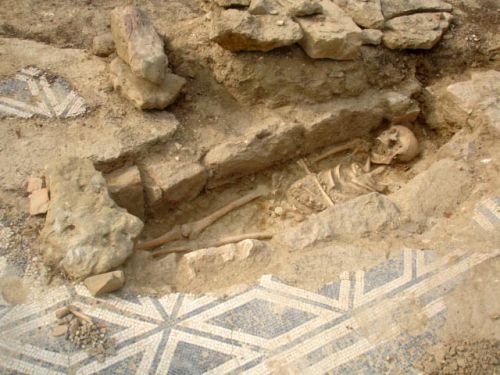
This was in late 2008, since then more excavations have been taking place. Do visit if you can and let me know your thoughts, either with an e-mail to me personally through "Contacter l'auteur" at the bottom of the page, or else by sending a commentary for all readers to read in the box below.
This beautiful wine-château is set in 150 hectares of gardens and vines. It is situated just to the south of Nissan in Hérault, not far from the village of Salles d'Aude near Coursan in Aude, from where it is sign-posted. Tel 04 67 37 00 30 or look at; www.chateaulavernede.com
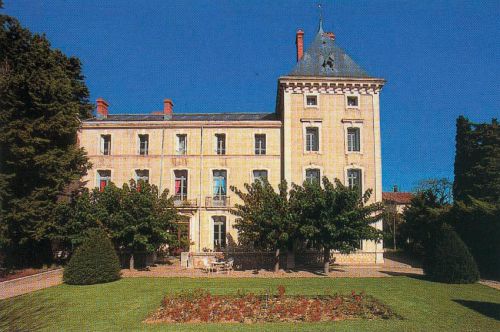
Baziège, near Toulouse
You can find this village just 20km to the east of Toulouse, just off the N113 Narbonne to Toulouse road. Immediately to the south of it are remains of an aqueduct over which the Main Roman Road, the Via Aquitana, crossed the marshes. It consists of 26 "pountils" or little bridges.
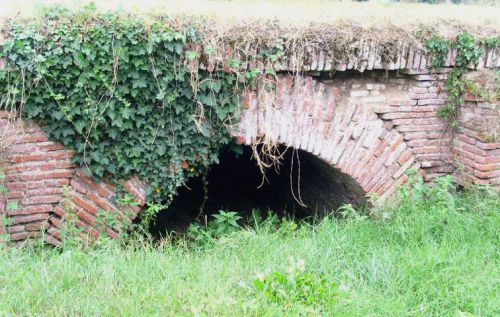

As you can see, the cars still drive over them, and even though the Romans built this to cross the marshes, housing estates are being built to either side of it, their foundations below the level of the road. "The Romans certainly knew better than we do," someone in our party said. The village itself is concerned that urbanisation might eat away at this valuable site.
This road, the Via Aquitana, linked Narbonne with Toulouse and this is the road that Ataulf, Wallia and Galla Placidia, Ataulf's queen, would have taken when they came to claim Toulouse, which became their Visigothic capital for nearly 100 years.
The modern town centre is entirely built in the "little red bricks" of the Toulouse area, as is the aqueduct, and is thus most attractive. Find the church of St. Etienne; in a side chapel is a Roman bourne or milestone, found on the Via Aquitana. This side chapel was built in Visigothic times and today's church grew up around it, a little at a time.
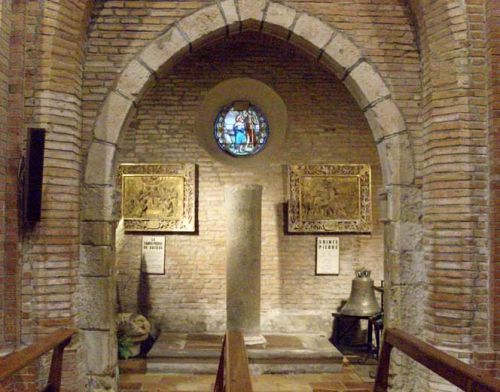
This implies the Visigoths also founded the village itself; maybe it began as a hostelry beside the Via Aquitana, but more research is needed. Certainly the municipality found plenty much pottery and roof-tiles when they built the local housing-estate called "Les Astrias."
There is a local legend that an early Christian martyr was tied up to the bourne and then "martyred' - killed. But whether he was martyred for being an Arian Christian, or for being a Roman Christian, no one knows.
A little to the north of Baziège is the chapel of St. Colombe - the basically rectangular shape, plus the one-time cemetary at the end now made into a car-park, implies this chapel was first built in Visigothic times.
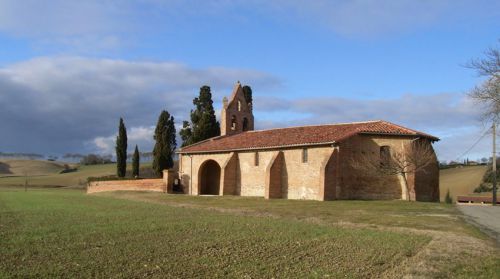
Liens
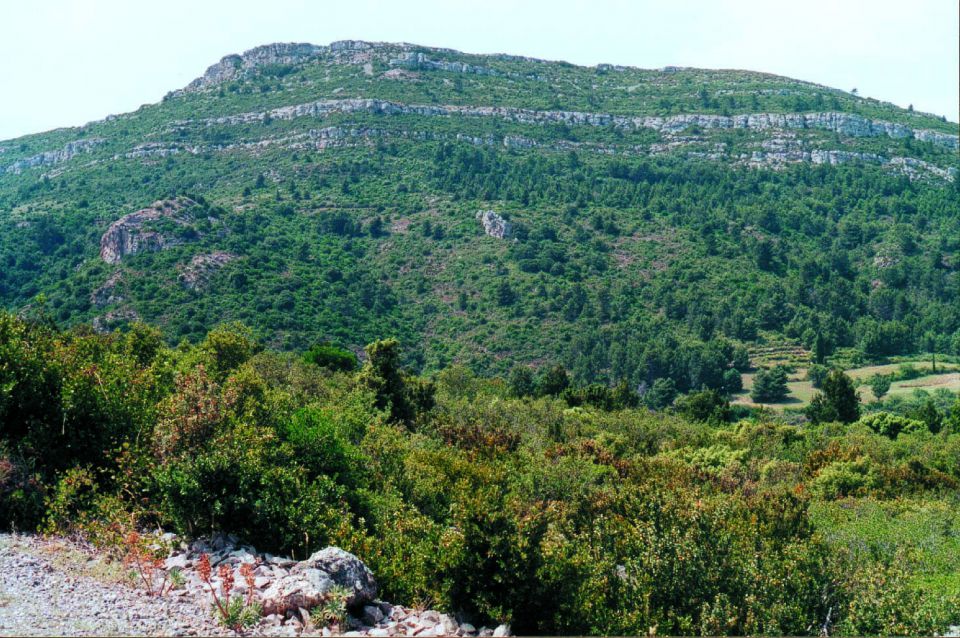

Commentaires
le 10/09/2010 à 14:38:34